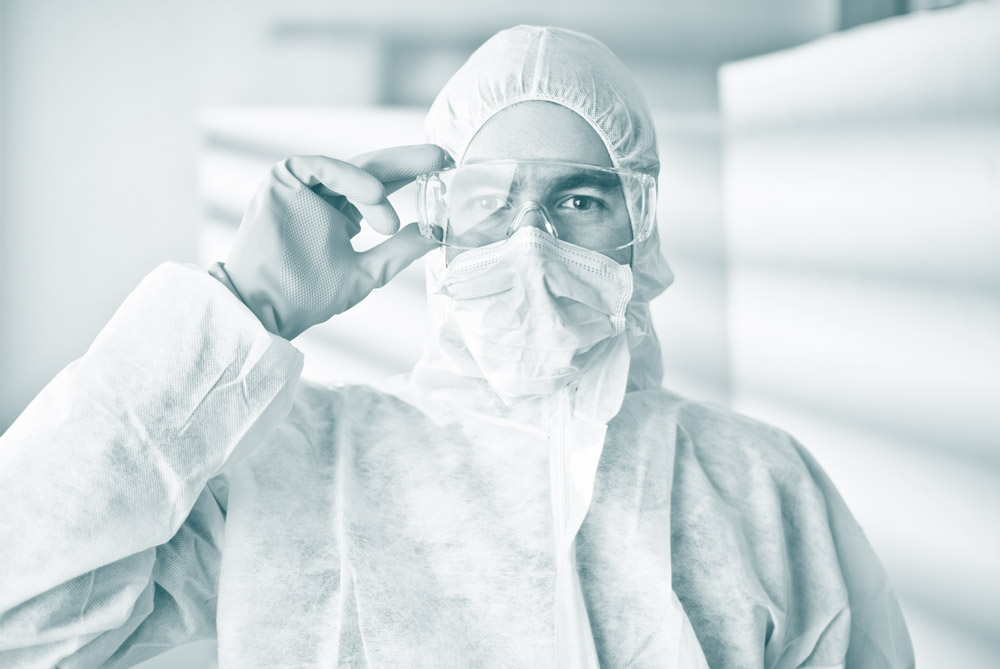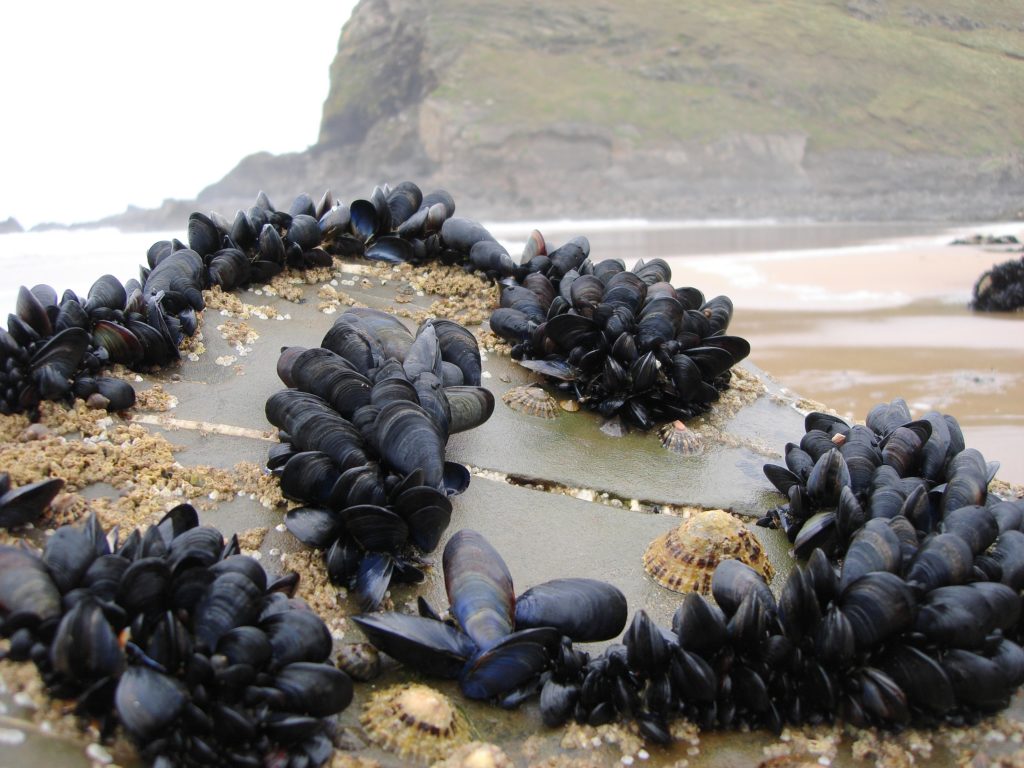Bio-Technology, Cleanroom News, Hospitals
How Mussel-Glue Is Transforming The Field Of Fetal Surgery
In our high-tech age where each generation is glued to a screen – texting, surfing, Instagramming, Snap-Chatting, tweeting – it’s refreshing to reflect back on earlier times. To recall the low-tech pastimes that did not rely on zeroes and ones, bits and bytes, but more on the innocence of childish wonder and learning. We’re thinking of those idyllic summers spent at the coast, digging in the sand, chasing siblings with stands of glistening bladderwrack, and discovering new worlds in the basin of a rockpool. Remember those halcyon days?
Well, even if you didn’t experience them directly, just pretend to own this childhood for one moment: breathe in the salty tang of the sea air, listen to the gulls wheeling overhead, and fight down the frustration of trying – and usually failing – to pry a mussel or a barnacle off the side of the rock pool. They were tenacious little creatures, clinging with an almost supernatural strength to their watery abode, and managing to dislodge them was an extraordinary accomplishment. But did you ever wonder how something so small could be so strong? Especially when it lived in a watery, slippery environment. If you are anything like bioengineer Philip Messersmith, founder of the Messersmith Research Group at the University of California-Berkeley, you did wonder just this. But the difference is that he took his childhood question further and, in so doing, sought to create a whole new generation of bio inspired materials…
First things first: what are mussels and why are they worth talking about?
So much more than the centerpiece of the dish moules frites, mussels are bivalves – creatures in the mollusk family that are most commonly found in intertidal zones close to coastal shores. Elongated in shape, their shells are composed of calcium carbonate in a protein matrix with the two halves hinged together at the base via twin sets of internal anterior and posterior adductor muscles. Another characteristic of the creature is its ‘foot,’ which is used both for mobility and for anchorage when stationary. But the most interesting characteristic of this diminutive animal – and the one that has scientists like Messersmith excited – is what’s commonly known as the mussel’s ‘beard.’
Byssel filaments, the ‘beard,’ are threads made of keratin and a family of compounds known as polyphenolic proteins containing oxidized tyrosine and cysteine that act as stiffeners. When a mussel encounters a potential new home – a surface to which it wishes to adhere – its muscular foot first secures it in place. Byssus, an adhesive foam, is then pumped into the vacuum chamber created by the foot and the foam is fashioned into threads. These threads are not only incredibly strong – achieving bond strengths of up to 500,000N/m2 – but also adhesive within a saline, watery environment.
…Messersmith began leveraging his work with ‘mussel glue’ to perfect ‘pre-sealing,’ a technique that could radically change the future of fetal surgical intervention.
So this is where it gets interesting. Let’s backtrack for a moment and take a closer look at Messersmith’s research. In his early work, Messersmith was a biologist who switched his attention to polymer science. Supported by a grant from the National Institutes of Health, the researcher moved from Northwestern University in Illinois to be proximal to the work underway at the University of California-San Francisco into improving the outcomes of fetal surgery. In collaboration with Michael Harrison, a pediatric surgeon and Professor Emeritus based at UCSF, Messersmith began leveraging his work with ‘mussel glue’ to perfect ‘pre-sealing,’ a technique that could radically change the future of fetal surgical intervention.
According to the Children’s Hospital of Philadelphia, approximately 4 million babies are born annually in the U.S., of which around 3% (or 120,000) have a significant birth defect.(1) However, with developments in the field of fetal imaging, diagnostics, and treatment this number is set to decline with many birth defects becoming correctable in utero, including the life-threatening condition spina bifida. Treating lung malformations, urinary tract or airway obstructions, and hernias may also be performed prior to birth, along with a variety of procedures deemed ‘minimally invasive,’ including the placement of bladder or chest shunts or stem cell transplantation. However other interventions, termed ‘fetoscopic,’ are more dangerous to the developing infant, given that they run the risk of inducing miscarriage due to the introduction of surgical tools that necessarily puncture the amniotic sac. As Harrison notes in a 2016 article published in Berkeley News, an online publication of the university: ‘“We have worried about this problem of fetal membranes leaking and causing pre-term labor and delivery for decades. […] It is the Achilles heel of fetal surgery.”’(2)
For Messersmith, however, L-dopa’s most significant characteristic was the effect it could have on strengthening his adhesive by allowing it to form chemically cross-linked polymers in the shape of a star.
But perhaps it might now be possible to render that particular Achilles heel impervious? Leveraging his background in polymer science, Messersmith created a synthetic polymer with DOPA, DOPA peptides, and DOPA-mimetic functional groups – catechols that facilitate cross-linking of proteins to allow adhesion between surfaces. In Messersmith’s formulation one specific amino acid – L-dopa – plays a critical role. To those outside of the medical profession, L-dopa is perhaps most well known as the miracle curative portrayed in director Penny Marshall’s 1990 film, ‘Awakenings.’ Inspired by the work of British neurologist Oliver Sacks, the movie starring Robin Williams as the fictitious doctor Malcolm Sayer, depicted Sacks’ research with catatonic survivors of an outbreak of encephalitis. Using L-dopa, Sacks was able to ‘awaken’ the patients and return them to a near normal life, at least temporarily. In the movie, ‘Sayer’ learns of L-dopa’s success in treating Parkinson’s disease and realizes the impact it could have on his neurologically petrified patients. An unusual amino acid, L-dopa is the precursor to the neurotransmitter dopamine, a chemical that is naturally created in an area of the brain stem known as the substantia nigra. In Parkinson’s disease, this area stops creating dopamine and synaptic messages are not conveyed through the brain. This lack of communication results in a range of muscular problems such as involuntary movement and contraction, coordination problems, reduced facial expressiveness, and impaired speech. It also often causes hand and limb tremors – the first telltale signs of the disease. However, when L-dopa is metabolized to once more create dopamine, the chemical balance is re-established and nerve cells communicate freely again. For Messersmith, however, L-dopa’s most significant characteristic was the effect it could have on strengthening his adhesive by allowing it to form chemically cross-linked polymers in the shape of a star. This proved to be the key to enhancing not only the strength of the glue in its cured state but also its adhesion to non-dry surfaces.
So how is this glue used in fetal surgery?
Using Messersmith’s compound, Harrison’s technique is unusual insofar as it involves creating a protected space between the uterine wall and the fetal membrane. Introducing an oblique needle, a bubble or ‘tent’ is created between the two surfaces into which the adhesive – a liquid sealant – is injected. Much like rubber in a mold, the sealant takes on the shape of the space and ‘cures’ quickly providing a patched area through which surgeons operate. The aim is to create a watertight seal around the surgical instruments as they penetrate the amniotic sac. Using Messersmith’s pioneering compound as a sealant, no amniotic fluid is lost during the procedure and the puncture self-seals upon completion of surgery.
But outside of the specialist field of fetal surgery, is this development useful in broader medicine? The answer is a resounding yes. At this time, most surgical wounds are generally closed using mechanical means – sutures, staples or clips depending to a large extent on the incision site, type of surgery, and individual patient. And these techniques are both efficient and cost-effective. In fact, in 2014 a group of researchers headed by J.C. Dumville conducted a meta-analysis of post-surgical wound care data, the results of which were reviewed by an international group of healthcare professionals associated with the Cochrane Wounds Group, a network based at the University of Manchester in the United Kingdom. What Dumville et al discovered was that while the trend for using tissue adhesives to close wounds offered an easier, safer, and less involved procedure, sutures remained the better option for minimizing dehiscence – the re-opening of the wound.(3)
But the one way in which adhesives outperform the other methods of closing wounds is in their ability to prevent contamination and to minimize infection.
Creating a complete closure for an open wound is critical in preventing opportunistic infection for up to thirty days following surgery, when infection can result from air-borne contamination, contact with non-sterile surgical instruments, contamination by the body’s own fluids, or contact infections from care givers. In a paper catalogued in the U.S. National Library of Medicine, National Institutes of Health, ‘Risk factors for wound infection after surgery for colorectal cancer,’ lead author T. Nakamura found that post-operative infections resulted in around 26% of patients in a study group at Kitasato University Hospital, Kanagawa Prefecture, Japan, who underwent open colectomy.(4) This incidence was found to negatively impact recovery rates and to increase the duration – and associated healthcare costs – of the hospitalization. Furthermore, in a study of 129 surgical patients in Veterans Affairs (VA) hospitals published in 2014, the mean unadjusted costs of treatment were $31,580 for patients who remained infection-free, rising to $52,620 for patients who subsequently developed a surgical site infection (SSI).(5)
According to an article published by Purdue University, the challenge faced by current tissue adhesives is that they can be toxic.
So if wound closure is the key to driving down SSI rates and tissue glue is the best available alternative, why is it not the de facto solution? One word: toxicity. According to an article published by Purdue University, the challenge faced by current tissue adhesives is that they can be toxic.(6) Some are made from blood-based materials and carry the risk of contamination and disease transmission. Others cannot be used internally as they degrade into potential carcinogens. And still others are known to provoke inflammatory reactions and surface irritation. Moreover, many of the available options are not effective in a moist environment. As Associate Professor of Chemical Engineering and Biomedical Engineering at Purdue University Julie Lui notes, most currently available surgical glue products ‘do not possess sufficient adhesion on an excessively wet environment and are not approved for application in wound closure. In fact, many of these materials specifically advise to dry the application area as much as possible.’(7) And so, like Messersmith, Lui set out to change that.
Partnering with Chemistry and Material Engineering Professor Jonathan Wilker and a team of students, Lui co-authored a paper published in Biomaterials, an international journal published by Elsevier, showcasing their new adhesive compound ELY16. An elastin-like polypeptide – or ELP – ELY16 combines elastin and tyrosine that has been converted into an adhesive DOPA molecule. Both the ELY16 and the converted DOPA molecule are non-toxic on a cellular level and are able to function extremely effectively under wet conditions. Like Messersmith’s mussel-glue, Lui’s ELP is strengthened via polypeptide cross-linking and also mimics the feel of soft tissue. Due to the relative density of the proteins, it also does not disperse in a wet environment making it a viable post-surgical wound closure. And the jewel in this particular research crown? Measuring the survival rate of NIH/3T3 rodent fibroblast cells after a 48 hours exposure to a layer of ELY16, the viability rate hovered above 95 percent. And the compound also boasts ‘outstanding biocampatiblility’ given its use of human elastin.(8)
Although the research is ongoing, it’s already clear that the use of surgical glues in wound closure is an exciting field of study.
The implications of this developing bio inspired technology in terms of wound treatment both within sterile environments such as hospitals and also perhaps in the theater of war are curtailed only by the extent of our creativity and imagination. And, of course, our willingness to look more closely at humble creatures such as bivalves like the mussel.
Do you have experience of surgery that involved glue? Would you still prefer staples or sutures? Let us know in the comments!
References:
-
- http://www.chop.edu/treatments/fetal-surgery/about
- http://news.berkeley.edu/2016/06/30/fetal-surgery-stands-to-advance-from-new-glues-inspired-by-mussels/
- http://www.cochrane.org/CD004287/WOUNDS_tissue-adhesives-for-closure-of-surgical-skin-incisions
- https://www.ncbi.nlm.nih.gov/pubmed/18404288
- https://www.ncbi.nlm.nih.gov/pubmed/24848779
- https://www.purdue.edu/newsroom/releases/2017/Q3/non-toxic-underwater-adhesive-could-bring-new-surgical-glue.html
- ibid






















Pingback: Fetal Surgery Is Being Transformed by Mussel Glue - Berkshire Singapore